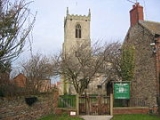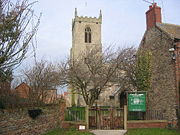
Eastrington
Encyclopedia
Eastrington is a small village and civil parish in the East Riding of Yorkshire
, England
. It is situated approximately 3 miles (4.8 km) to the east of Howden
.
The civil parish is formed by the village of Eastrington and the hamlet
s of Newland
, Owsthorpe
and Portington
.
According to the 2001 UK census
, Eastrington parish had a population of 880.
The village is served by Eastrington railway station
(formerly "South Eastrington") on the Hull
to Selby
railway line
, and was historically also served by North Eastrington railway station on the Hull and Barnsley Railway
.
Nearby Eastrington Ponds is a Local Nature Reserve
.
The village is served by a local shop and the Black Swan public house
.
 St Michael's Church, Eastrington is tucked away in the heart of the village. The church is mentioned in the Domesday survey of 1086, listed as part of the Howden manor
St Michael's Church, Eastrington is tucked away in the heart of the village. The church is mentioned in the Domesday survey of 1086, listed as part of the Howden manor
and in 1146 Eastrington was specifically mentioned as a chapel of Howden
. Architecturally the church displays a confusing mixture of historical influences. The present chancel
was probably in the original chapel. The walls are Norman
with chamfered string courses both inside and out, as are the carved stone inside the building, steps on which the font stands and the gargoyles.
Surviving records from accounts at Durham
suggest that monk
s paid for some of the early medieval building work, while the north and south aisles were later additions and probably paid for by three local families - the Askes, Kayvills (or Cavilles) and Portingtons.
In the Portington
chapel, a 'coffin shaped cross slab with lead filled design' can be found on the floor dated from the early 13th century, also a second cross slab carved in relief, dated from the late 13th century. There is a shield below the cross head, probably the Caville coat of arms
.
Architectural evidence suggests that much of St Michael's Church building surviving today was built during the 14th century. The windows of the chapel are typical of the 14th century and a tombstone recorded as being in the church in 1584 was inscribed with the words "Orate pro animabus Nicholai de Portington, militis, qui istam capellam fieri fecit" (Pray for the soul of Nicholas Portington, knight, who caused this chapel to be built). It is thought to be that of Nicholas Portington who was still alive in 1327.
East Riding of Yorkshire
The East Riding of Yorkshire, or simply East Yorkshire, is a local government district with unitary authority status, and a ceremonial county of England. For ceremonial purposes the county also includes the city of Kingston upon Hull, which is a separate unitary authority...
, England
England
England is a country that is part of the United Kingdom. It shares land borders with Scotland to the north and Wales to the west; the Irish Sea is to the north west, the Celtic Sea to the south west, with the North Sea to the east and the English Channel to the south separating it from continental...
. It is situated approximately 3 miles (4.8 km) to the east of Howden
Howden
Howden is a small market town and civil parish in the East Riding of Yorkshire, England. It lies north of the M62, on the A614 road about north of Goole and south-west of York. William the Conqueror gave the town to the Bishops of Durham in 1080...
.
The civil parish is formed by the village of Eastrington and the hamlet
Hamlet (place)
A hamlet is usually a rural settlement which is too small to be considered a village, though sometimes the word is used for a different sort of community. Historically, when a hamlet became large enough to justify building a church, it was then classified as a village...
s of Newland
Newland, East Riding of Yorkshire
Newland is a hamlet in the East Riding of Yorkshire, England. It is situated approximately north east of Goole and lies north of the B1230 road and straddles the M62 motorway. It is served by Eastrington railway station on the Hull to York railway line....
, Owsthorpe
Owsthorpe
Owsthorpe is a small hamlet in the East Riding of Yorkshire, England. It is situated approximately north east of Goole and lies north of the M62 motorway.It forms part of the civil parish of Eastrington....
and Portington
Portington, East Riding of Yorkshire
Portington is a hamlet in the East Riding of Yorkshire, England. It is situated approximately north east of Goole and lies east of the A614 road.It forms part of the civil parish of Eastrington.-References:...
.
According to the 2001 UK census
United Kingdom Census 2001
A nationwide census, known as Census 2001, was conducted in the United Kingdom on Sunday, 29 April 2001. This was the 20th UK Census and recorded a resident population of 58,789,194....
, Eastrington parish had a population of 880.
The village is served by Eastrington railway station
Eastrington railway station
Eastrington railway station serves the village of Eastrington in the East Riding of Yorkshire, England. The station is 19¼ miles west of Hull on the Hull-York Line...
(formerly "South Eastrington") on the Hull
Kingston upon Hull
Kingston upon Hull , usually referred to as Hull, is a city and unitary authority area in the ceremonial county of the East Riding of Yorkshire, England. It stands on the River Hull at its junction with the Humber estuary, 25 miles inland from the North Sea. Hull has a resident population of...
to Selby
Selby
Selby is a town and civil parish in North Yorkshire, England. Situated south of the city of York, along the course of the River Ouse, Selby is the largest and, with a population of 13,012, most populous settlement of the wider Selby local government district.Historically a part of the West Riding...
railway line
York & Selby Lines
The York & Selby Lines is the name given to a group of services in the West Yorkshire Metro area, connecting Leeds with places to its north and east: as well as the Northern Rail local services to York and Selby, the services extend to:...
, and was historically also served by North Eastrington railway station on the Hull and Barnsley Railway
Hull and Barnsley Railway
The Hull Barnsley & West Riding Junction Railway and Dock Company was opened on 20 July 1885. It had a total projected length of 66 miles but never reached Barnsley, stopping a few miles short at Stairfoot. The name was changed to The Hull and Barnsley Railway in 1905...
.
Nearby Eastrington Ponds is a Local Nature Reserve
Local Nature Reserve
Local nature reserve or LNR is a designation for nature reserves in the United Kingdom. The designation has its origin in the recommendations of the Wild Life Conservation Special Committee which established the framework for nature conservation in the United Kingdom and suggested a national suite...
.
The village is served by a local shop and the Black Swan public house
Public house
A public house, informally known as a pub, is a drinking establishment fundamental to the culture of Britain, Ireland, Australia and New Zealand. There are approximately 53,500 public houses in the United Kingdom. This number has been declining every year, so that nearly half of the smaller...
.
St. Michael's Church

Manorialism
Manorialism, an essential element of feudal society, was the organizing principle of rural economy that originated in the villa system of the Late Roman Empire, was widely practiced in medieval western and parts of central Europe, and was slowly replaced by the advent of a money-based market...
and in 1146 Eastrington was specifically mentioned as a chapel of Howden
Howden
Howden is a small market town and civil parish in the East Riding of Yorkshire, England. It lies north of the M62, on the A614 road about north of Goole and south-west of York. William the Conqueror gave the town to the Bishops of Durham in 1080...
. Architecturally the church displays a confusing mixture of historical influences. The present chancel
Chancel
In church architecture, the chancel is the space around the altar in the sanctuary at the liturgical east end of a traditional Christian church building...
was probably in the original chapel. The walls are Norman
Norman architecture
About|Romanesque architecture, primarily English|other buildings in Normandy|Architecture of Normandy.File:Durham Cathedral. Nave by James Valentine c.1890.jpg|thumb|200px|The nave of Durham Cathedral demonstrates the characteristic round arched style, though use of shallow pointed arches above the...
with chamfered string courses both inside and out, as are the carved stone inside the building, steps on which the font stands and the gargoyles.
Surviving records from accounts at Durham
Durham
Durham is a city in north east England. It is within the County Durham local government district, and is the county town of the larger ceremonial county...
suggest that monk
Monk
A monk is a person who practices religious asceticism, living either alone or with any number of monks, while always maintaining some degree of physical separation from those not sharing the same purpose...
s paid for some of the early medieval building work, while the north and south aisles were later additions and probably paid for by three local families - the Askes, Kayvills (or Cavilles) and Portingtons.
In the Portington
Portington, East Riding of Yorkshire
Portington is a hamlet in the East Riding of Yorkshire, England. It is situated approximately north east of Goole and lies east of the A614 road.It forms part of the civil parish of Eastrington.-References:...
chapel, a 'coffin shaped cross slab with lead filled design' can be found on the floor dated from the early 13th century, also a second cross slab carved in relief, dated from the late 13th century. There is a shield below the cross head, probably the Caville coat of arms
Coat of arms
A coat of arms is a unique heraldic design on a shield or escutcheon or on a surcoat or tabard used to cover and protect armour and to identify the wearer. Thus the term is often stated as "coat-armour", because it was anciently displayed on the front of a coat of cloth...
.
Architectural evidence suggests that much of St Michael's Church building surviving today was built during the 14th century. The windows of the chapel are typical of the 14th century and a tombstone recorded as being in the church in 1584 was inscribed with the words "Orate pro animabus Nicholai de Portington, militis, qui istam capellam fieri fecit" (Pray for the soul of Nicholas Portington, knight, who caused this chapel to be built). It is thought to be that of Nicholas Portington who was still alive in 1327.

